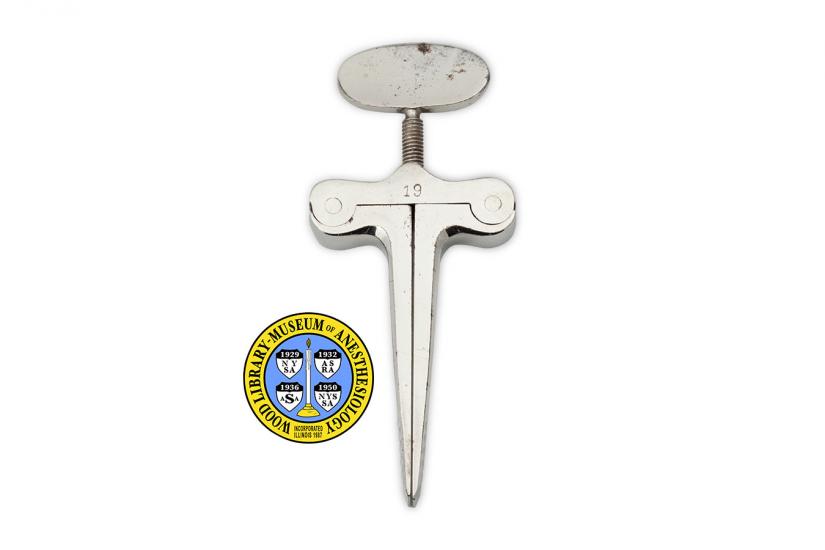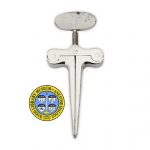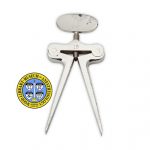Heister Mouth Gag
Mouth gags are devices used to hold the mouth open. In medicine, they were originally used for procedures and surgery in the mouth and throat, or for opening the mouths of patients who could not do so themselves.
During anesthesia the muscles in the back of the mouth, throat and jaw relax, sometimes causing the airway to the lungs to become obstructed. Also, patients under light chloroform or ether anesthesia sometimes clenched their mouths closed as a normal reflex. For these reasons, mouth gags were sometimes used to keep the mouth and airway open and accessible during anesthesia. Their use for this purpose waned after better anesthetics, oral airways and endotracheal tubes came into practice. However, mouth gags are still used today for procedures and surgeries involving the mouth and throat.
This gag was introduced in 1718 by the accomplished German surgeon, Lorenz Heister (1683-1758). It is also referred to as the Mott-Heister Gag. In 1829, New York City surgeon Valentine Mott (1785-1865) wrote of the instrument he used on a young man who had been unable to open his mouth for at least 10 years. When told about the Heister Gag, introduced more than 110 years earlier, Dr. Mott responded, “It is a little amusing that this instrument, thought to be unique, should have produced its counterpart, and a claim to originality at so distant a period.”
Catalog Record: Heister Mouth Gag
Access Key: akuu
Accession No.: 2010-09-23-7 A
Title: [Mott modification of the Heister mouth gag.]
Author: Mott, Valentine, 1785-1865.
Author: Heister, Lorenz, 1683-1758.
Title variation: Alt Title
Title: Heister mouth gag, Mott modification.
Title variation: Not Applicable
Title: Heister’s mouth gag.
Title variation: Alt Title
Title: Mott-Heister’s mouth gag.
Title variation: Alt Title
Title: Mott-Heister gag.
Title variation: Alt Title
Title: Mott-Heister Speculum Oris.
Title variation: Alt Title
Title: Mott’s Heister’s oral speculum.
Publisher: [Place of manufacture not indicated] : [Name of manufacture not indicated], [between 1893 and 1970].
Physical Descript: 1 mouth gag : metal ; 5.5 x 1.5 x 13 cm.
Subject: Anesthesia, Dental – instrumentation.
Subject: Surgical Instruments.
Subject: Anesthesia, Inhalation – instrumentation.
Subject: Airway Management – instrumentation.
Subject: Airway Management Equipment.
Subject: Mouth Gags.
Subject: Trismus – therapy.
Subject: Otorhinolaryngologic Surgical Procedures – instrumentation.
Note Type: General
Notes: Title based on the WLM common name for the object.
Note Type: General
Notes: The early year in the date range for the possible year of manufacture is
based on a tag made by a previous owner, Dr. Daniel Revell. On the tag is
written, “Mott’s Heister’s Oral Speculum for breaking up morbid adhesions &
lockjaw. Price 11 shillings. 1893 London. Revell.” The end-year in the range
is an estimate. It is loosely based on the year that Dr. Revell retired from
pediatric anesthesiology, 1968. The date range could change if documentation
that indicates the dates should be corrected is discovered.
Note Type: Citation
Notes: Ball C, Westhorpe R. Clearing the airway—mouth gags, wedges and openers.
Anaesth Intensive Care. 1997;25(4):335.
Note Type: Citation
Notes: Kirkup J. Heister’s mouth gag. J Med Bio. 2007;15(3):185.
Note Type: Citation
Notes: Morris LE. Daniel G. Revell (b. 1904). Canadian J Anesth. 1994;41(5):450.
Note Type: Citation
Notes: Mott V. Case of immobility of the jaw, successfully treated. Am J Med Sci.
November, 1829;5(9):102-104. https://books.google.com/books?id=J3RDAAAAYAAJ.
Accessed April 7, 2014.
Note Type: Citation
Notes: Sweet AL. Medicine in New York City in the 60’s: “There were giants in those
days.” Med Rec. November 25, 1916;90(22):939.
Note Type: Physical Description
Notes: One mouth gag with heavy, symmetrical steel bars joined to form t-shaped
instrument; The beveled bars taper toward the ends; The proximal ends (from
the patient’s perspective) have heavy transverse serrations; The bars are
joined to each end of a heavy steel bar which has a threaded hole in the
center; A screw with an oval handle fits through the hole and controls the
opening and closing of the bars; The only marking is a number, “19”, stamped
on one side of the joining bar; There are scratches throughout and some
corrosion on the oral handle; A tag written by Dr. Revell is written with,
“Mott’s Heister’s Oral Speculum for breaking up morbid adhesions & lockjaw.
Price 11 shillings. 1893 London. Revell.”
Note Type: Reproduction
Notes: Photographed by Mr. Steve Donisch, September 18, 2013.
Note Type: Acquisition
Notes: Donated to the WLM by Lucien E. Morris, M.D. Previously owned by Daniel
Revell, MD.
Note Type: Historical
Notes: Mouth gags are devices used to hold the mouth open. In medicine, they were
originally used for procedures and surgery in the mouth and throat, or for
opening the mouths of patients who could not do so themselves.
During anesthesia the muscles in the back of the mouth, throat and jaw relax,
sometimes causing the airway to the lungs to become obstructed. Also,
patients under light chloroform or ether anesthesia sometimes clenched their
mouths closed as a normal reflex. For these reasons, mouth gags were
sometimes used to keep the mouth and airway open and accessible during
anesthesia. Their use for this purpose waned after better anesthetics, oral
airways and endotracheal tubes came into practice. However, mouth gags are
still used today for procedures and surgeries involving the mouth and throat.
This gag was introduced in 1718 by the accomplished German surgeon, Lorenz
Heister (1683-1758). It is also referred to as the Mott-Heister Gag. In 1829,
New York City surgeon Valentine Mott (1785-1865) wrote of the instrument he
used on a young man who had been unable to open his mouth for at least 10
years. When told about the Heister Gag, introduced more than 110 years
earlier, Dr. Mott responded, “It is a little amusing that this instrument,
thought to be unique, should have produced its counterpart, and a claim to
originality at so distant a period.”
Note Type: Publication
Notes: Hoefert S. The evolution of mouth gags: presentation of a new modificated
Denhart mouth gag. J Maxillofac Oral Surg. December, 2013;12(4):475-479.
Note Type: Publication
Notes: Lorenz Heister (1683-1758): eighteenth century surgeon. JAMA. December 11,
1967;202(11):1048-1049.
Note Type: Exhibition
Notes: Selected for the WLM website.



